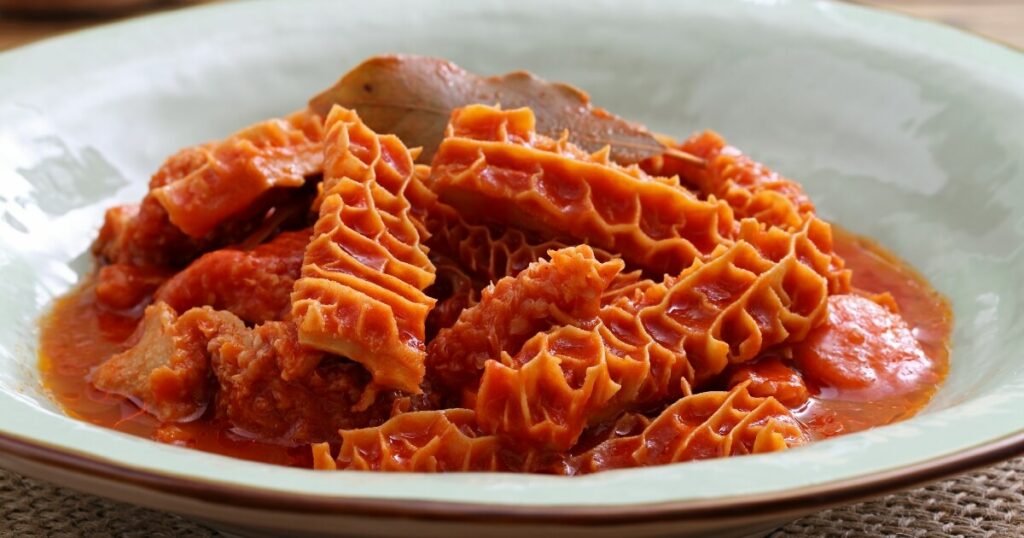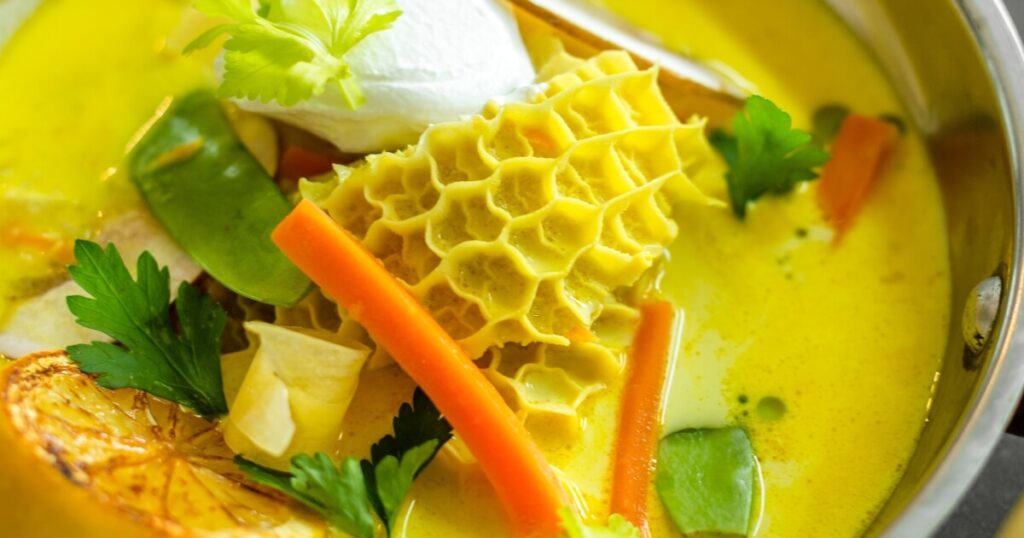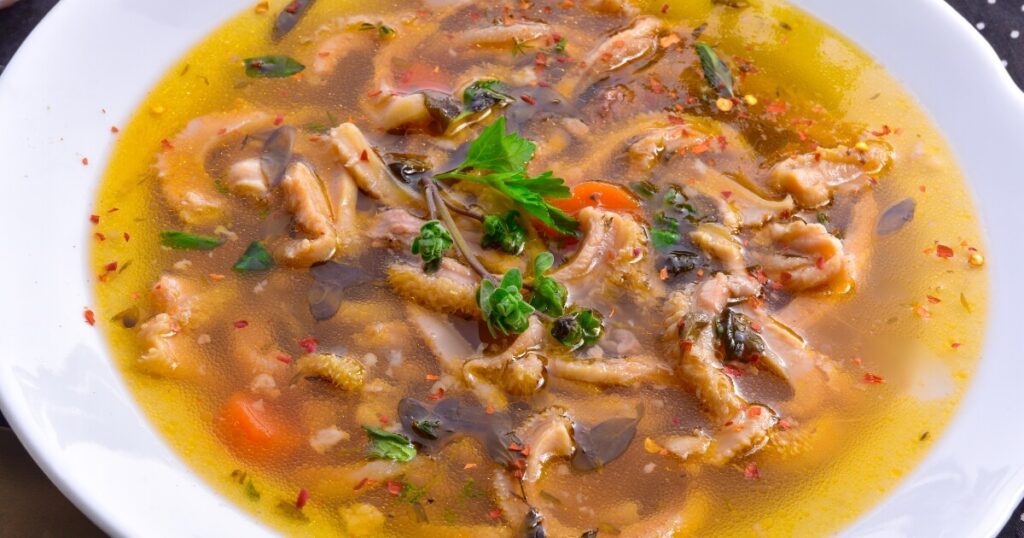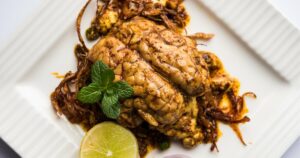Tripe, a culinary term that might sound exotic to some, is actually a humble ingredient with a rich history in global cuisine.
It refers to the edible stomach lining of various animals, with beef tripe being the most popular version that you’ll come across here in the US.
As a home cook, I’ve found that understanding the taste of an ingredient like tripe is like getting to know a new friend. The more you understand about them, the better you can work together.
With that in mind, keep reading to learn more about its taste and texture and how to use it in your everyday cooking.
How Does Tripe Taste?
The taste of tripe is mild and slightly sweet compared to chicken or calamari. Its standout feature is its ability to absorb the flavors of the ingredients it’s cooked with, making it a versatile addition to various dishes.

When you first encounter tripe, you might be surprised by its unique texture.
It’s chewy and a bit spongy, but when cooked right, it becomes tender. This texture is a standout feature, contrasting dishes, particularly hearty soups and stews.
What Does Tripe Compare With?
The taste and texture of tripe can be compared to:
- Chicken Gizzards: Like tripe, chicken gizzards have a chewy texture and a mild flavor that absorbs the taste of the ingredients they’re cooked with.
- Squid: The chewy, rubbery texture of tripe is somewhat similar to that of squid. However, squid has a more distinct, slightly sweet, and briny flavor.
- Liver: In terms of flavor, tripe can be compared to liver as they both have a slightly gamey taste. However, liver has a much softer, creamier texture compared to the chewiness of tripe.
- Tofu: Tofu and tripe are similar in that they both absorb the flavors of the ingredients they’re cooked with. However, tofu has a much softer, more delicate texture than tripe.
- Oxtail: Oxtail and tripe are both types of offal and have a similar gamey flavor. However, oxtail is much more tender and has a richer, meatier flavor than tripe’s mild taste.
What Does Tripe Look Like?
Tripe is quite distinctive in appearance, and its unique look is usually what draws people to try it in the first place.
Raw tripe is typically a pale white or light gray color with a slightly shiny, moist surface. It’s made up of thick, ridged layers that give it a somewhat spongy texture.

You’ll notice that tripe has a patterned surface when you look closely.
This is especially true for honeycomb tripe, which has a characteristic honeycomb pattern that gives it its name. On the other hand, Book Tripe has smoother, flatter layers that resemble the pages of a book.
Once cooked, tripe takes on a translucent, almost gelatinous appearance. It becomes softer and more pliable, but it retains its chewy texture.

Depending on how it’s cooked, it might take on the color of the sauce or broth it’s cooked in, ranging from a rich red in a tomato-based sauce to a deep brown in a soy-based broth.
One of the most notable features of tripe is its size. A single piece of tripe can be quite large, often requiring to be cut into smaller pieces before cooking.
Varieties Of Tripe
Tripe comes from the stomach lining of various animals, and the taste can differ depending on the type. Here are a few varieties you might come across:
- Beef Tripe: This is the most common type of tripe you’ll find. It comes from cows and is used in dishes like Menudo. Beef tripe has a mild, slightly sweet flavor and a chewy texture.
- Pork Tripe: Pork tripe is a bit less common but is used in many Asian cuisines. It has a similar texture to beef tripe but can have a slightly stronger flavor.
- Lamb Tripe: Lamb tripe is rare and has a stronger, more gamey flavor than beef and pork tripe. It’s often used in traditional Middle Eastern dishes.
- Honeycomb Tripe: This type of beef tripe gets its name from its honeycomb-like texture. It’s the most tender and flavorful part of the cow’s stomach and is highly prized in many cuisines.
- Book Tripe: Also known as leaf tripe, this is another type of beef tripe. It’s thinner and less fatty than honeycomb tripe, with a more delicate flavor.
- Green Tripe: This is unprocessed, unbleached tripe that still contains some of the cow’s last meal, which can give it a strong, pungent odor. It’s rarely used in human cuisine but is often used in pet foods.
How To Eat Tripe
Tripe is a versatile ingredient that can be prepared in a variety of ways. Here are a few popular methods of preparation and dishes that include tripe:
Tripe Soup

One of the most common ways to eat tripe is in soup. The tripe is thoroughly cleaned, then simmered for several hours until it becomes tender.
It’s often cooked with various vegetables and spices, giving the soup a rich, hearty flavor.
The tripe absorbs the soup’s flavors, making it a delicious and warming dish, especially in the colder months.
Tripe Stew

Tripe stew is another popular dish. Similar to tripe soup, the tripe is cooked until tender, then combined with ingredients such as potatoes, carrots, and onions.
The stew is typically seasoned with herbs and spices, and the tripe absorbs these flavors as it cooks.
Tripe in Sauce
Tripe is also often cooked in a rich, flavorful sauce. This could be a tomato-based sauce, a spicy miso sauce, or any other type of sauce you prefer.
The tripe is simmered in the sauce until it’s tender and has absorbed the flavors of the sauce. Serve with rice or bread to soak up the delicious sauce.
How To Make Tripe Taste Good
Making tripe taste good is all about the preparation and the flavors you pair it with. Here are some tips to help you make the most of this unique ingredient:
- Clean Thoroughly: Tripe needs to be cleaned thoroughly before cooking. This usually involves rinsing it under cold water and scrubbing it with coarse salt to remove any impurities.
- Long Cooking Time: Tripe requires a long cooking time to become tender. Simmering it in a flavorful broth for several hours will make it tender and allow it to absorb the flavors of the broth.
- Use Flavorful Ingredients: Since tripe has a mild flavor, it’s best to cook it with strong, flavorful ingredients. This could be a rich tomato sauce, a spicy chili sauce, or a savory miso broth.
- Season Well: Don’t forget to season your tripe well. Salt, pepper, herbs, and spices can all help to enhance its flavor.
Tripe FAQs
What type of meat is tripe?
Tripe is a type of offal which refers to a butchered animal’s internal organs and entrails. Specifically, tripe is the edible lining from the stomach of various farm animals, most commonly cows.
What is tripe made of?
Tripe is made from the stomach lining of animals. The most common type of tripe comes from cows and is made from one of the three chambers of the cow’s stomach: the rumen (blanket/flat tripe), the reticulum (honeycomb and pocket tripe), or the omasum (book/bible tripe).
Can dogs eat tripe?
Yes, dogs can eat tripe, which is quite good for them. Green tripe, which is raw and unprocessed, is often used in pet foods because it’s rich in nutrients and beneficial bacteria. However, it’s always best to consult with a vet before introducing new foods into your pet’s diet.


